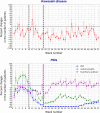Kawasaki Disease and Pediatric Infectious Diseases During the Coronavirus Disease 2019 Pandemic
- PMID: 34324881
- PMCID: PMC8591269
- DOI: 10.1016/j.jpeds.2021.07.053
Kawasaki Disease and Pediatric Infectious Diseases During the Coronavirus Disease 2019 Pandemic
Abstract
Objective: To assess the epidemiologic association between Kawasaki disease and common pediatric infectious diseases (PIDs) identified during the coronavirus disease 2019 (COVID-19) pandemic period to confirm whether the infection-triggered theory is a plausible hypothesis for the pathogenesis of Kawasaki disease.
Study design: A retrospective epidemiologic study was conducted using datasets obtained from Web-based surveillance of Kawasaki disease and PIDs in Japan. We compared weekly numbers of patients who developed Kawasaki disease and specific PIDs between 2020 and 2017-2019 and evaluated the association between the percent reduction in the number of patients with these diseases.
Results: A total of 868 patients developed Kawasaki disease in 2020. During the social distancing period in 2020, the number of patients with Kawasaki disease was approximately 35% lower than in 2017-2019. Time from the onset of Kawasaki disease until the first hospital visit did not differ significantly among the examined years. The proportion of older children with Kawasaki disease decreased more than that of infants with Kawasaki disease (age <1 year), resulting in a significant difference in the proportion of infant patients between 2020 and 2017-2019 (24% vs 19%; P < .01). The number of patients with incomplete Kawasaki disease was unchanged from that of previous years. The weekly percent reduction in patient numbers differed between Kawasaki disease and PIDs during 2020, with no strong correlation between the 2 diseases.
Conclusions: Our data indicate that parents of patients with Kawasaki disease did not avoid hospital visits during the COVID-19 pandemic period. The findings indicate the possibility that triggering Kawasaki disease might be associated with presently unidentified respiratory pathogen(s) that potentially might be acquired from both within and outside the household.
Keywords: Kawasaki disease; coronavirus disease-2019 pandemic; etiology; pediatric infectious disease.
Copyright © 2021 Elsevier Inc. All rights reserved.
Figures





Comment in
-
An Unintended Consequence of Pandemic Control Measures: Fewer Cases of Kawasaki Disease.J Pediatr. 2021 Dec;239:11-14. doi: 10.1016/j.jpeds.2021.08.069. Epub 2021 Aug 26. J Pediatr. 2021. PMID: 34454952 Free PMC article. No abstract available.
References
-
- Ae R., Makino N., Kosami K., Kuwabara M., Matsubara Y., Nakamura Y. Epidemiology, treatments, and cardiac complications in patients with Kawasaki disease: the Nationwide Survey in Japan, 2017-2018. J Pediatr. 2020;225:23–29.e2. - PubMed
-
- Makino N., Nakamura Y., Yashiro M., Kosami K., Matsubara Y., Ae R., et al. Nationwide epidemiologic survey of Kawasaki disease in Japan, 2015-2016. Pediatr Int. 2019;61:397–403. - PubMed
-
- Makino N., Nakamura Y., Yashiro M., Sano T., Ae R., Kosami K., et al. Epidemiological observations of Kawasaki disease in Japan, 2013-2014. Pediatr Int. 2018;60:581–587. - PubMed
-
- McCrindle B.W., Rowley A.H., Newburger J.W., Burns J.C., Bolger A.F., Gewitz M., et al. Diagnosis, treatment, and long-term management of Kawasaki disease: a scientific statement for health professionals from the American Heart Association. Circulation. 2017;135:e927–e999. - PubMed
MeSH terms
LinkOut - more resources
Full Text Sources
Medical

